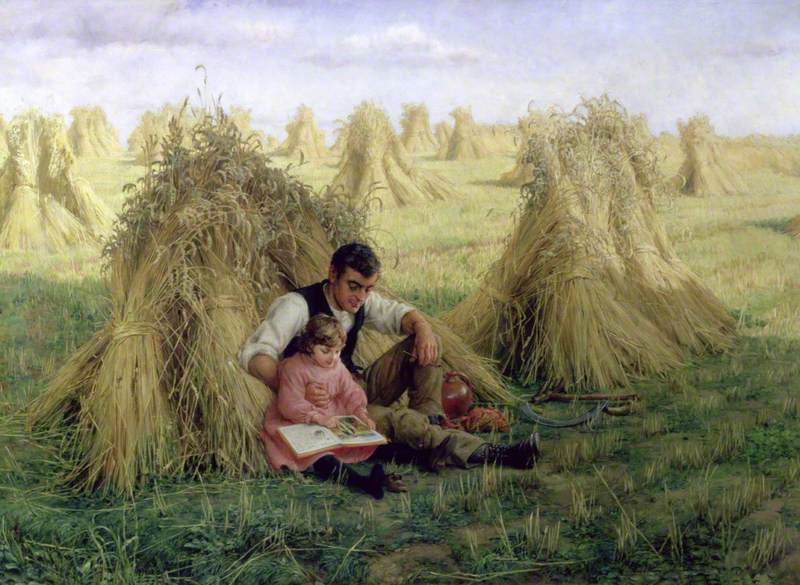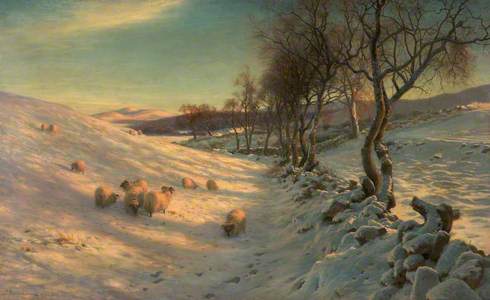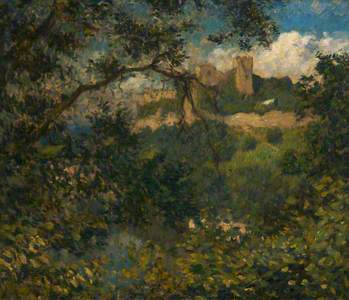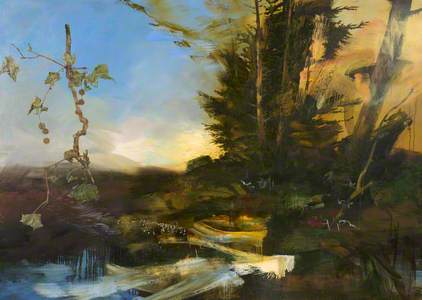Running from 22 March 2014 to 7 March 2015, the exhibition ‘Four Seasons in One Day’ at Touchstones Rochdale in Lancashire reflected on the town’s relationship with the countryside. Here, the team from the arts centre reveal highlights from the show.
1.
Gloucester Gate, Regent's Park, London, Summer, Autumn, Winter, Spring
1977/1979
Adrian Berg (1929–2011) 
Views of nature have historically dominated representations of the seasons, depicting pastoral scenes, changeable weather, events and activities associated with them.
The painting above highlights the changing seasons in Regent’s Park, London, as seen from the artist’s studio in nearby Gloucester Gate.
2.
The Story of Ruth and Boaz
1894
Frank William Warwick Topham (1838–1924) 
The moral virtue of labour and the generosity of sharing are celebrated in this work.
The wheatsheaf evokes a message of unity and strength. It was heavily used by the cooperative movement, which was founded in Rochdale.
The father and daughter are reading the story of Ruth and Boaz, a Biblical tale set in a field of grain.
The importance of the harvest makes it the focus of seasonal celebrations found in many religions.
3.
Joseph Farquharson’s landscape paintings usually capture the warmth and light of the rising or setting sun, and feature snowy scenes with sheep.
Inspired by the natural surroundings of his family home, the Finzean Estate in Aberdeenshire, Farquharson painted from a mobile studio.
With this invention he could paint virtually in the open air in the most inhospitable conditions.
4.
Richmond Castle through the Trees, North Yorkshire
c.1939
Philip Wilson Steer (1860–1942) 
Philip Wilson Steer studied in Paris during the early 1900s, joining the New English Art Club when he returned.
During the late nineteenth and early twentieth centuries, the group went on to influence and inspire many artists, and exhibit at the Royal Academy of Arts in London.
With Walter Sickert, Steer became a leading British Impressionist. The air of sunny France is evident in his style and representation of Richmond Castle in North Yorkshire.
5.
Alan Rankle was born in Oldham, Lancashire.
His paintings combine elements of traditional European landscape painting with a distinctive individuality.
Rankle aims to mix the power and depth of traditional landscape art with the spontaneous energy of Abstract Expressionism.
Thick layers of paint and dynamic washes of colour explore contemporary concerns about the environment.
6.
Originally this artwork was attributed to artist Edwin Ellis and had the title Picking Cherries.
However, recent conservation treatment revealed it was actually a depiction of people harvesting wild cobnuts.
Research questioned the painting’s attribution to Ellis and, after surface dirt and varnish were removed, the signature of Vladimir Sherwood was discovered.
7.
Norman Stevens belonged to a group of artists which included David Hockney.
They studied at Bradford College of Art in the 1950s and went on to establish major reputations.
Heavily influenced by Pop Art, Stevens' style developed while teaching at various art schools.
Landscaped gardens and contrasting rural compositions became his preferred subjects. However, it was light and shade – as shown in this sundrenched summer scene – that fascinated him
throughout his career.
8.
An Easter Holiday, the Children of Bloomsbury Parochial School in a Wood at Watford
1874
James Aumonier (1832–1911) 
A painter of quiet pastoral landscapes and animals, Aumonier worked in oils and watercolours.
Typical of many self-taught artists, he initially worked as a designer of printed calicoes and spent his spare time painting.
This work depicts the innocence of children as they play in the woods picking primroses, a symbol of early youth. In the Victorian period, girls were often associated with flowers and imagery personifying their youthful naivety and chastity.
9.
Therese Lessore studied at the Slade School of Art and was a founder member of the London Group in 1913.
The themes she painted regularly included landscapes, interiors and circus subjects.
Before mechanisation replaced handpicking in the 1960s, the hop gardens of Kent required a large temporary workforce to harvest the crops each September.
This included many from the East End of London, Roma travellers and workers from Ireland.
10.
Canal near Bruges, Belgium, Autumn
Louis Joseph Reckelbus (1864–1958) 
Louis Reckelbus was born in Belgium. He painted landscapes, interiors and still lifes, mostly in watercolour, but also used tempera.
During the First World War, he fled the country for St Ives in Cornwall.
Although Reckelbus is well known in Belgium, he only managed to bring a few works with him to the UK.
Consequently he is not very well represented in British public collections.
Editor's note: This story first appeared on the BBC Arts website. The BBC is an Art UK project partner.
















